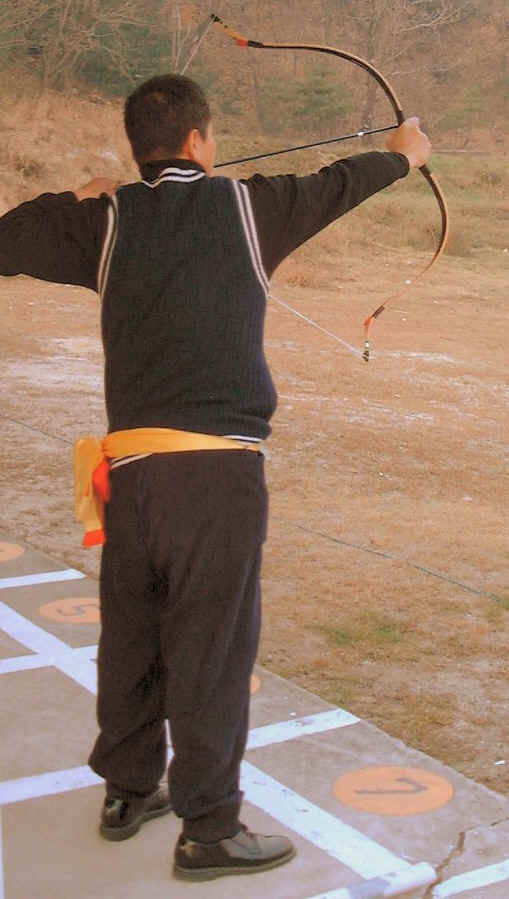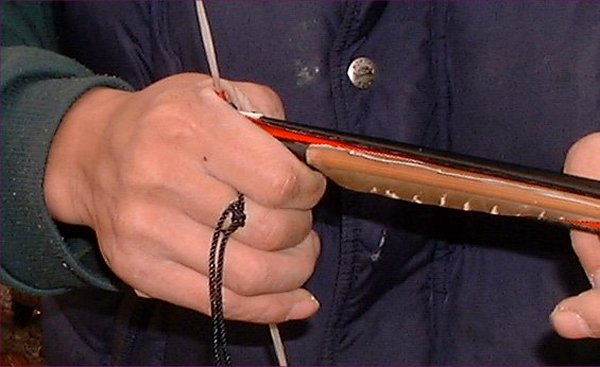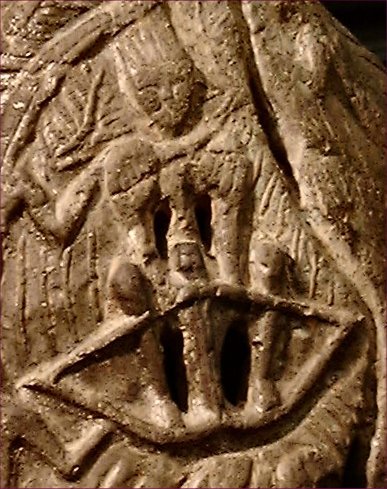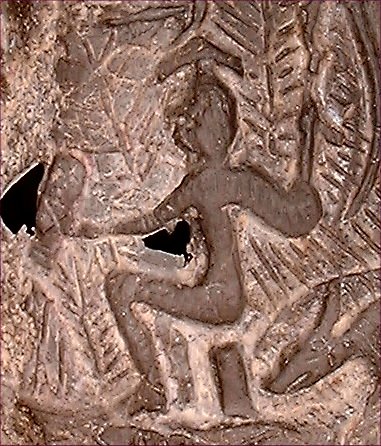
Asian Traditional Archery Research Network (ATARN)
Text and
photographs © Stephen Selby, 2001.
A1, Cloudridge,
30, Plunkett’s Road,
The Peak, Hong Kong.
Fax: (852) 2808-2887
email: srselby@atarn.org
December 2001
Dear All,
ATARNet has been up and running for a month. It's certainly easier on the eyes that the previous Discussion Forum. I am still ironing out some bugs, but I think most Members have been happy with it.
In last month's discussions, we achieved the most thorough examination in history of Philippine water buffalo horn (there's nothing you can't find on the Internet!) There have been some other interesting discussion threads and some fine photos have been up-loaded. Remember that there is more than one page to the ATARNet forum now. Make sure you check out 'page 2...' so that you don't lose out on interesting threads.
I have had an interesting few days' discussion with Hong Kong's Museum of Coastal Defence, which will host my collection of Asian archery equipment for five years. Realistically, the exhibition will not be ready for formal opening until the middle of May, 2002. We plan to have a formal opening ceremony and to have a decent, printed catalogue for the exhibition. You are all warmly welcome to attend!
Tentatively, we think that ATARN's symposium on Asian archery should be held at the museum here in Hong Kong to coincide with the opening. The bowyer from Peking, Ju Yuan Hao, has been invited, and we are hoping to have bow and arrow makers from Korea present as well. We might be able to get a participant from Mongolia, and it would be great if we could have someone from Japan.
Please mark your diaries for the exhibition opening and possible symposium in mid-May, 2002.
In November I was in Korea. I was lucky to be able to make short visits to the Korean Military Academy as well as the Bows and Arrows Museum in Paju.

Col. Ki-Hoon Kim of the Korea Army Museum kindly met me and took me around the facility. The museum comprehensively covers Korean military history. It is a wonderful opportunity to study Chinese military history as well, because there has been a long cultural cross-fertilization between the two cultures.
The Military Museum has an outstanding collection of archery equipment, covering bows, arrows, quivers, accessories, crossbows and archery-derived machines of war. The collection is well displayed and well-lit ─ but be forewarned that there are no labels in English!
|
|
|
What impressed me most was the group of young officer-cadets (both men and women) who were learning traditional Korean archery under the tutelage of archer/bowyer Kim Keong-won. Mr Kim is descended from three generations of Korean bow-makers. His father did not pass on his skills; but Kim Keong-won took the initiative to learn the craft from Bowyer Park Geuk-hwan of Kyongju.

|
|
|
I had a good chat with the Korean officer-cadets about the English longbow tradition and the points of excellence of the Korean horn bow. I also demonstrated some points of Chinese archery: they were quite amused at the thought of blind nocking an arrow.
A long drive took me, Tom and Nick Duvernay to Paju to visit the Bows and Arrows Museum set up by master fletcher Young-gi Yoo. We were shown around by his son, Se-hyun Yoo, who is a master fletcher in his own right.

Unlike some other archery cultures in Asia, Korean bowyers and arrow-makers are fascinated by the bows and arrows of other cultures, as well as equipment that has been used in historical times gone by. This curiosity has led the Yoo father and son to explore Korean bow and arrow making in its broad historical and geographical context. The result is a museum which is rich in reproductions of historical equipment (particularly arrows and crossbows.)
Here, you can see a demonstration of six ground-mounted crossbows rigged to fire in unison. The forward movement of the bow-limb of one crossbow whips out a chock which triggers the firing of the adjacent one. The result sounds like a burst of muffled automatic fire.
|
|
|
Bede Dwyer introduced me to the use of the side-arrow guide (Arabic and Turkish Majra). I had a chance to study its use in the hands of an expert, Se-hyun Yoo. The side arrow is the logical extension of the idea of an overdraw. The tube - a fist longer than a full-size arrow, accepts a short dart. Such darts can achieve enormous speeds and better still, without the same equipment, the enemy can't shoot the short darts back.

The Korean arrow-guide has some special features. In some Middle-Eastern guides, the guide is a half-cylinder, so that the "wrap-around" of the dart does not exceed 180 degrees. The Korean guide has a wrap-around of around 225 degrees. Used with an ordinary dart, there is still a risk that if the dart is not well-seated in the guide at the release, it may jump out and hit the archer's wrist.
In battle, experienced archers used a conventional dart and relied on their skill to avoid such accidents. But learners used a dart which had a bulb in the shaft a distance above the point. Once inserted correctly into the guide, the bulb stops the dart from coming out of the guide. This prevents accidents, but makes for more friction between the dart and the guide, so that an plain dart was preferred for use by experienced archers.

How the arrow guide is held
Using an arrow guide is dangerous. In the last year, there has been a serious accident using one in Korea. Please be very cautious about trying to make and use your own.
Preoccupied with the prospect of his own mortality, The first emperor of China, Qin Shi Huang (259-210 BCE) was said to have sent ship-loads of young men and virgins to search for the island of Penglai where, it was said, the herb of eternal life grows. Whatever the young men and virgins got up to on their travels, it did not include coming home with and magical herbs!
The legends lived on to the Western Han Dynasty, when it was fashionable to bury incense-burners in the shape of the mythical island with the dead. Once lit, the smoke from the incense seeped out through holes in the cover of the burner and formed swathes of mist around fantastic scenes of immortals hunting deer, tigers, bears and mystical chimera.
I came across one such incense burner in Hong Kong last week.

The incense-burner is made of high-fired , unglazed gray clay. It is typical of the clay burial items made in Sichuan, western China, in Western Han times. The cover is in the shape of a conical mountain top. Animals are depicted (lizards, snakes, dogs, deer, an elephant and tigers) together with human-like Daoist immortals.
For us, the interest is in the Daoist immortals, some of whom are armed with crossbows for the hunt. Others are restraining dogs on leashes, or beating drums or cymbals.

Loading a crossbow.
In the above photograph of the incised design, the raised teeth of the lock are visible at the top of the crossbow stock, and the general proportions of the crossbow prods to the stock, as well as the proportion of the whole assembly to the hunter, can be seen. (The human-like arm and leg on the left actually belong to an enormous lizard!)

An immortal with a special head-dress sits on a tree stump
beating a small drum or cymbal.
We should safely be able to assume that these scenes represent the way that the Han aristocracy went on hunting parties. A genre of poetry of that time, the 'Fu' style, often described hunting trips in the royal hunting parks in lavish language. If you look at some of the Chinese crossbows I have described on ATARN, clearly we are looking at hunting equipment for the aristocracy rather than a foot-soldier's weapon of war.

Going hunting with a crossbow
Again we get a clear impression of the size and proportion of the early Han crossbow. The hunter seems to have a wooden table or case strapped over his shoulder. It's too big for crossbow quarrels (but it would be handy for a hunting rifle and telescopic sight!) I wonder what it was used for...
I look forward to reading your answers on ATARNet.
|
|
(Signed) (Stephen Selby) |